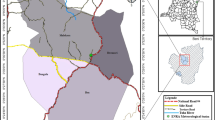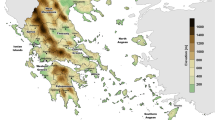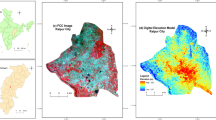Abstract
The temperature and humidity of the shelterbelt micro-climate on both horizontal and vertical scales in the extremely drought area were measured with multiple HOBO temperature and humidity automatic observation equipments in the hinterland of the Taklimakan Desert. The results show that the shelterbelt ecosystem of the desert highway plays typical micro-climate adjustment rolesin stabilizing surface air temperature and increasing air humidity, and so on. Solar radiation significantly affects both temperature and humidity of surface layers, and it has a positive correlation with the temperature but a negative correlation with the air humidity. When it is cloudy, the weather has a great impact on keeping temperature and humidity in the shelterbelt. The shelterbelt also significantly influences the environment, and the micro-climate in the belt has an obvious characteristic of cooling and humidification: compared with the original sand area, the temperature in the shelterbelt is always lower and the humidity is always higher. Moreover, the temperature range at the shelterbelt edge is greater than that in the sand area, but the humidity is always higher. Our conclusion is that the vertical-effect range of temperature of the shelterbelts is 4–10 m, and the humidity range is 6 to 8 m; the horizontal-effect range of temperature is 16 m and the humidity range is about 24 m.
Similar content being viewed by others
References
Zhu T T, Guan D X. Farmland Shelterbelt Ecological Project (in Chinese). Beijing: China Forestry Press, 2001
Cao X S. Farmland Shelterbelt (in Chinese). China Forestry Press, 1983
Xie P, Li Y. Micro-climate effect in coastal sand shelterbelt (in Chinese). China’s Deserts, 2001, 21(1): 93–96
Hipsey M R, Sivapalan M, Clement T P, et al. A numerical and field investigation of surface heat fluxes from small wind-sheltered water bodies in semiarid western Australia. Environ Fluid Mech, 2004, 4: 79–106
Wang H J, Zhou H. A Simulation study on the eco-environmental effects of 3N shelterbelt in North China. Glob Planet Change, 2003, 37: 231–246
Zhu N, Li M, Chai Y X. Analysis on ecological functions of Harbin Green System (in Chinese). J Appl Ecol, 2002, 13(9): 1117–1120
Chang J, Pan X D, Ge Y, et al. Micro-climate characteristics in Qinggang evergreen broad-leaf forest (in Chinese). J Ecol, 1999, 19(1): 68–75
Liu W J, Zhang K Y, Wang C M, et al. Research on micro-climate characteristics of Xishuangbanna dry season forest canopy of the tropical rain forest (in Chinese). J Ecol, 2001, 21(3): 486–491
Liu X Q, Shi Y H, Cai S, et al. Research on micro-climate of different forest structures in the area of the Three Gorges Project (in Chinese). Hubei Forest Sci Tech, 1998, (1): 1–5
Ma G F, Cui X M, Liu J, et al. Comparative study on climate effects of two types of poplar farmland shelterbelt (in Chinese). Inner Mongolia Agr Univ J, 2005, 26(1): 42–45
Yu J Q. Soil Improvement effect of woodland field shelterbelt in semiarid areas (in Chinese). Northeast Forest Univ J, 2001, 29(2): 55–58
Li D W, Gao Y, Gao Z Y, et al. Micro-climate characteristics of subalpine Minjiang fir forests in western Sichuan (in Chinese). Sichuan Forest Sci Tech, 2006, 27(6): 30–34
Li H T, Chen L Z. Research on micro-climate in warm temperature mountain forest (in Chinese). J Plant Ecol, 1999, 23(2): 139–147
Yang M J, Huang J G, Huang S G et al. Micro-climate characteristics of sparse monsoon and mixed red pine forest (in Chinese). Forestry Res, 1998, 11(5): 560–563
Bai Y Y. Observation and research on micro-climate in Daqingshan Water Conservation Forest (in Chinese). Inner Mongolia Forest College J (Natural Science), 1999, 21(3): 23–28
Sun S P, Zhu L H, Zeng C, et al. Feasibility study on the construction of biology sand control system in Tazhong Oilfield Base (in Chinese). Arid Zone Res, 2002, 19(11): 21-19–22
Yu H N. Global ecological problems and forest ecological value (in Chinese). Forest Meteorol Ser Sets, 1990, 6(3): 7–11
Wu L L, Zhang F. Research on temperature of Nanjing urban forest (in Chinese). Nanjing Forestry Univ J (Natural Science), 2003, 27(6): 31–34
Yan M, Zhong Z C, Qiao X H. Preliminary study on the micro-climate edge effect in Jinyun Mountain clips evergreen broad-leaf forest (in Chinese). J Appl Ecol, 2006, 17(1): 17–21
He S F, Jiang D M, Ala Mu-sa, et al. Research on the effect of sand conservation of Caragana microphylla shrub in Horqin sands (in Chinese)]. Soil Water Cons J, 2007, 21(1): 84–87
Author information
Authors and Affiliations
Corresponding author
Additional information
Supported by Major Orientation Foundation of the CAS Innovation Program (Grant No. KZCX3-SW-342), CAS Action-Plan for West Development (Grant No. KZCX2-XB2-13), Major Scientific and Technological Special of Xinjiang Uygur Autonomous Region (Grant No. 200733144-3), the research projects of the Tarim Branch of PetroChina Company Limited (Grant Nos. 971008090016 and 971008090017), and CAS Xinjiang Institute of Ecology and Geography “Dr. Talent” Project of Oasis Scholars Training Plan
About this article
Cite this article
Wang, H., Lei, J., Li, S. et al. Effect of the shelterbelt along the Tarim Desert Highway on air temperature and humidity. Chin. Sci. Bull. 53 (Suppl 2), 41–52 (2008). https://doi.org/10.1007/s11434-008-6004-5
Received:
Accepted:
Published:
Issue Date:
DOI: https://doi.org/10.1007/s11434-008-6004-5




